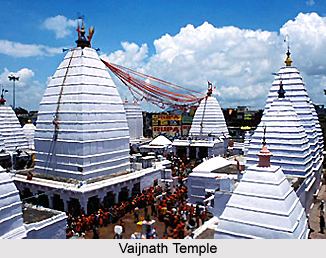 Vaijnath Temple which is also known as Baidyanath temple and Vaidyanath temple is one of the well visited pilgrimage in India. Located at the Deoghar district of Santhal pargana in Jharkhand, this is one of the twelve Jyotir lingams of India. With an exemplary architecture and a number of legends this is one of the most attractive sights in Jkarkhand that attract a large number of tourists. This temple is also known for various kinds of miracles that appease its devotees who visit the place from far off places. Devotees of Vaidyanath temple believe that whenever the devotees worship the deity with true faith and piousness, all their worries and miseries get relieved. It is also believed that worshipping in this temple attains to Moksha and helps the devotees to reach maximum level of Sadhana. As such the devotees carry Kanwars on their shoulder and begin the most devoted journey of twelve Jyotir lingams that gets completed after reaching this particular Shrine.
Vaijnath Temple which is also known as Baidyanath temple and Vaidyanath temple is one of the well visited pilgrimage in India. Located at the Deoghar district of Santhal pargana in Jharkhand, this is one of the twelve Jyotir lingams of India. With an exemplary architecture and a number of legends this is one of the most attractive sights in Jkarkhand that attract a large number of tourists. This temple is also known for various kinds of miracles that appease its devotees who visit the place from far off places. Devotees of Vaidyanath temple believe that whenever the devotees worship the deity with true faith and piousness, all their worries and miseries get relieved. It is also believed that worshipping in this temple attains to Moksha and helps the devotees to reach maximum level of Sadhana. As such the devotees carry Kanwars on their shoulder and begin the most devoted journey of twelve Jyotir lingams that gets completed after reaching this particular Shrine.
Vaijnath Temple includes a number of legends. According to the most popular legends this jyotirlingum was carried by Ravana who was blessed by Lord Shiva. As Ravana challenged Lord Shiva for lifting up the Kailash Parvat and in the process challenge Lord Shiva, he was appeased by Shiva who gave him one of the jyotir lingums which he should carry very carefully and establishes it in Lanka. However Lord Shiva dictated that wherever this lingam is placed it shall get rooted with the soil itself which cannot be uprooted by any one it will continue to exist till eternity. But the condition was that it must be established with utmost sanctity and purity. Following the instructions Ravana carried the Lingam very carefully which he wanted to establish in Lanka. On his way he was deceived by Lord Varuna and Lord Vishnu who created such conditions that Ravana had to hand over the lingam to a little child who was an incarnation of Lord Vishnu. Before Ravana could realize the child established the lingam. Disappointed Ravana then volunteered to shred off his nine heads for Shiva, who recovered his heads with the most superior Vaid of Trilok. After this incident the place came to be known as Vaidyanath which is considered as Shiva`s incarnation.
Along with this some believe that the place is one of the 51 Shakti piths on which the heart of Devi Sati fell after the body of Sati was chopped off by the Chakra of Lord Vishnu. Also few of the local devotees claim that as the place was discovered by a cowherd Baiju, it has been named after him.
Vaijnath Temple, besides its legends, is also known for its architectural marvel. Located at Deoghar this temple includes a spacious courtyard bound by stone walls. The temple complex includes twenty two other temples. Facing towards the east the temple has a shiva linga with a slightly broken top. This associated the temple with the legend of Ravana which claims that the lingam was broken when Ravana tried to uproot it. Near the temple there is Shivaganga Lake. Overall the temple has a splendid architecture which attracts the devotees from all places.
Thus Vaijnath temple is one of the most revered temples in east of India. With the legendary Shiva lingam and many more gods and goddess it has been revered for ages which adds to the glory of the temple.





















